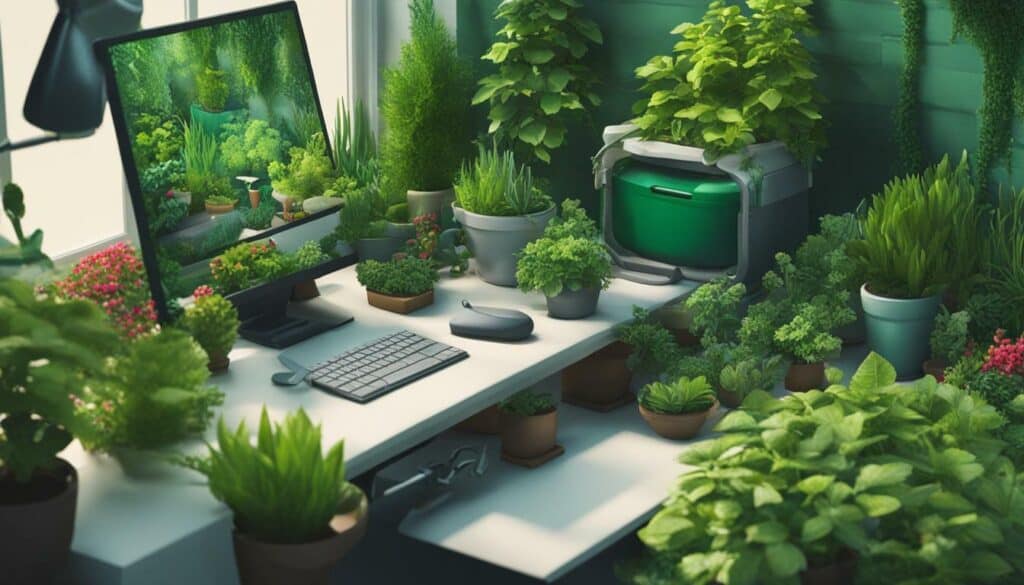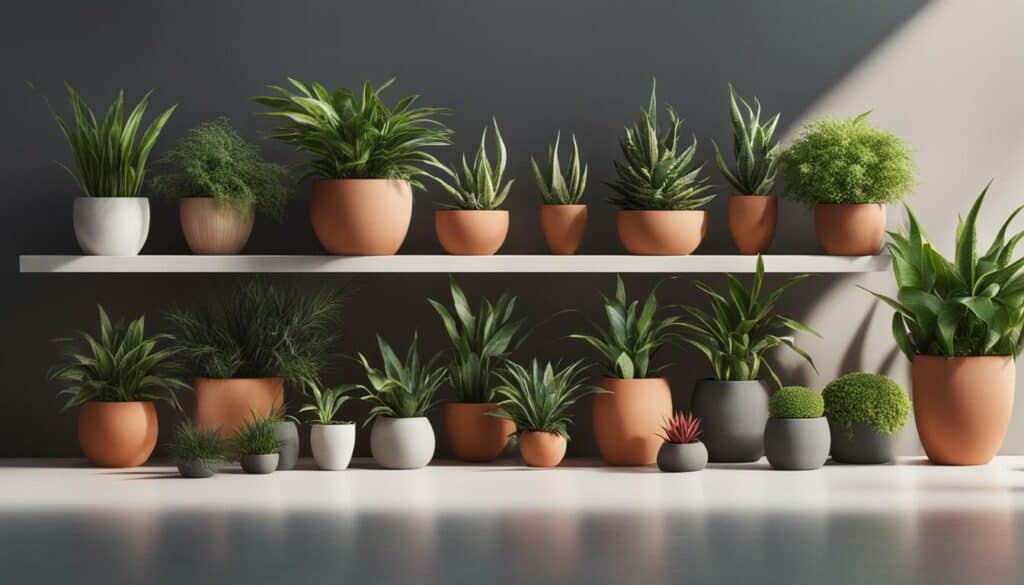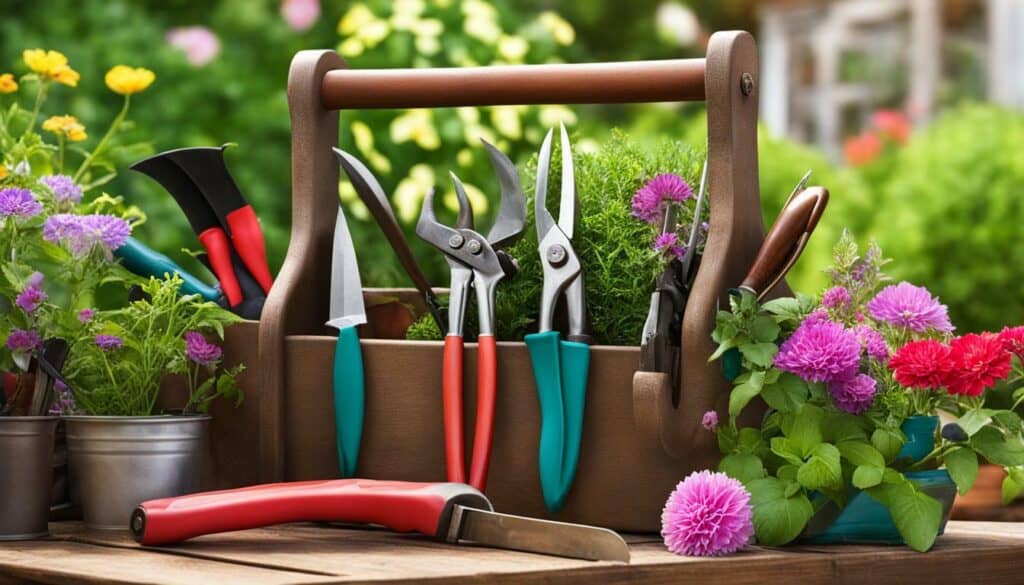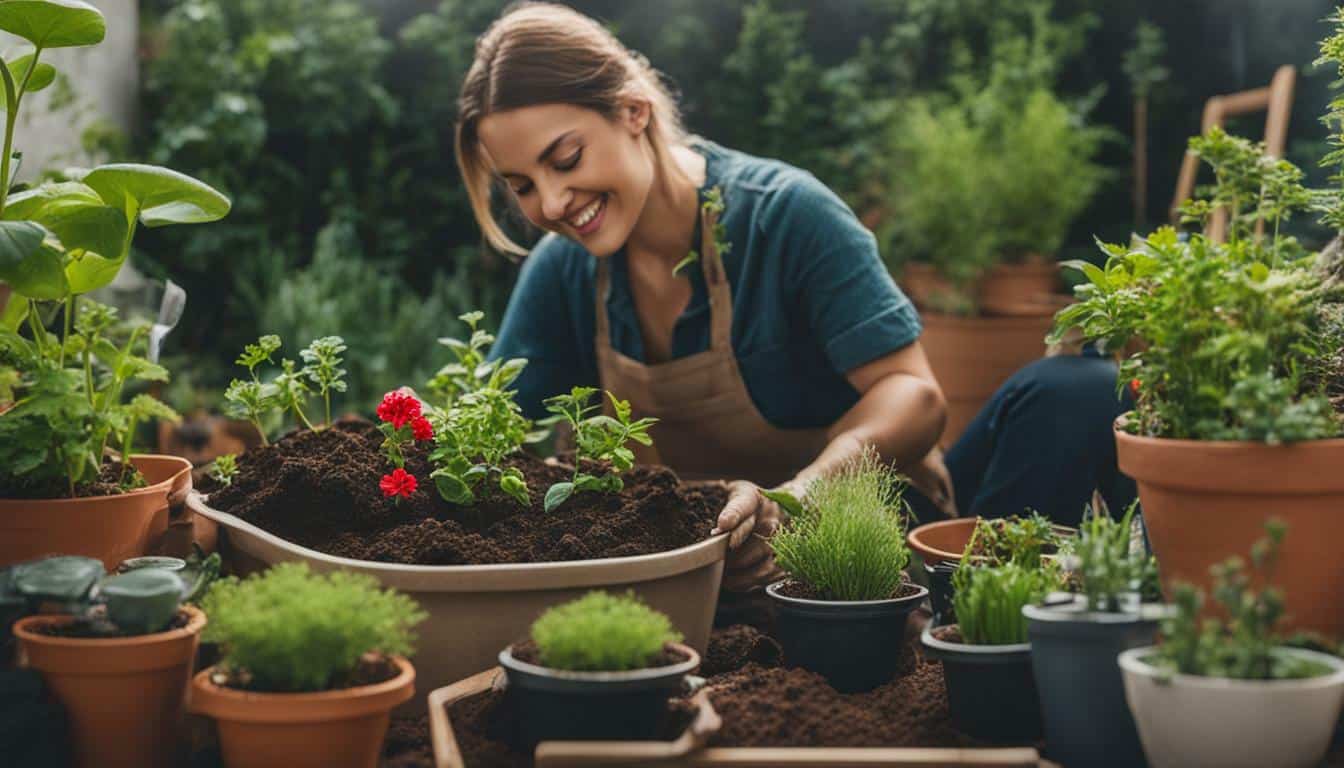Gardening can be a fulfilling hobby, and even beginners can create beautiful gardens with the right knowledge and resources. If you’re new to gardening or have limited outdoor space, tub gardening is a great way to start. Tub gardening is a simple and convenient way to grow your own plants in containers, and it is an ideal option for those who live in apartments or have limited outdoor space. In this article, we will discuss the basics of tub gardening and provide essential tips for beginners looking to start a garden in containers.
Key Takeaways:
- Tub gardening is a great option for beginners or those with limited space.
- Basics of tub gardening include understanding gardening tasks, different types of plants, and plant needs.
- Online courses can provide deeper learning opportunities for aspiring gardeners.
- Container gardening essentials, selecting and caring for plants, and key tips for successful gardening are key to a healthy thriving garden.
Understanding Basic Gardening Tasks
As a beginner gardener, understanding basic gardening tasks is crucial for the health and survival of your plants. Some basic gardening tasks include amending soil with organic matter, pruning shrubs, and dealing with pests and diseases.
Amending soil is important for improving soil quality and providing the necessary nutrients for plants to grow. Organic matter like compost, aged manure, or leaf mold can be added to the soil to improve its structure and fertility.
Pruning shrubs is necessary to shape and maintain their size. This also promotes healthy growth and prevents diseases. Pruning should be done during the dormant season to avoid damaging young growth.
Dealing with pests and diseases is necessary for maintaining healthy plants. Common pests like aphids, mealybugs, and spider mites can be controlled with insecticidal soap or neem oil. Fungal diseases like powdery mildew can be prevented by providing good air circulation and not overwatering.
Learning how to grow different types of plants such as annuals, perennials, shrubs, bulbs, vegetables, and herbs is also essential. Each plant has unique growth habits and requirements for sunlight, soil, and water.
It is important to understand gardening terms such as annual, perennial, shrub, evergreen, deciduous, zone, exposure, habit, and height & spread. This will help you choose the right plants for your garden and ensure their proper care.
Gardening can also be done indoors during winter, and there are various DIY projects inspired by the garden. However, it is crucial to know your gardening zone, have the right tools and supplies, choose the right location based on light conditions, and start with good soil. Composting and making leaf mold can help improve soil quality.
When it comes to planting, it is important to dig a hole twice the size of the plant’s rootball, tease the roots, and choose the right soil for in-ground or container planting. By understanding these basic gardening tasks, you’ll be on your way to a successful and thriving garden!

Growing Different Types of Plants
Beginners can learn how to grow different types of plants, such as annuals, perennials, shrubs, and bulbs, as well as vegetables and herbs. Depending on your preferences and gardening zone, you can choose to grow a beautiful flower garden or a practical vegetable garden.
Annuals are plants that complete their life cycle in one growing season. They offer colorful blooms and are available in a wide variety of shapes and sizes. Perennials, on the other hand, come back year after year and are a great investment for your garden. Shrubs are woody plants that can grow to be small or large. They provide structure and form to the garden while also offering blooms. Bulbs are underground storage structures that produce flowers. They can be planted in the fall for spring blooms or in the spring for summer blooms.
Vegetables and herbs are also great options for tub gardening. They provide fresh produce for cooking and are relatively easy to grow. Some popular options include tomatoes, peppers, lettuce, basil, and mint.
When choosing plants for your tub garden, it’s important to consider the amount of sunlight they require and whether they are compatible with each other. Some plants can thrive together while others may compete for resources. It’s also helpful to read and save the plant tags to learn about the specific needs of each plant.
Proper acclimation is important for the plants’ growth and survival. When bringing new plants home, it’s best to gradually expose them to their new environment to avoid shock. Providing sufficient potting soil is also important for their growth. Make sure the soil is well-draining and that the plants have enough space to grow.
Remember that gardening is a continuous learning process, and not all plants may thrive. Stay curious and open to trying new things as you explore the world of gardening.

Considering Plant Needs
It’s important to consider the amount of sunlight and shade a plant needs, as well as its growth habit, height, and spread. Sun-loving plants like tomatoes, peppers, and herbs require at least six hours of direct sunlight per day, while shade-loving plants like hostas and ferns prefer partial to full shade. Understanding a plant’s growth habit is also crucial, as some plants like to spread out while others grow tall and upright.
When selecting plants for a tub garden, it’s important to choose varieties that will thrive in containers. Look for plants that are labeled as suitable for container gardening or have a compact growth habit. It’s also a good idea to consider the mature size of a plant and ensure that it will fit comfortably in the container without becoming root-bound.
To ensure that plants thrive in a tub garden, it’s important to provide them with well-draining potting soil and regular water. Fertilizer is also necessary, as container-grown plants quickly deplete the nutrients in the soil. It’s recommended to fertilize plants every two to three weeks with a balanced fertilizer.
Understanding Gardening Terms
Understanding gardening terms like hardiness zones and exposure can help beginners choose the right plants for their garden. Gardening terms relate to the specific requirements of plants, such as their growth habit, sunlight needs, and temperature tolerance. Knowing these terms will help you communicate with other gardeners and ensure proper care for your plants.
One important gardening term is hardiness zone, which is based on the average minimum temperature in a specific geographic region. The United States Department of Agriculture (USDA) has created a map that divides the country into 13 zones based on temperature. Each zone is divided into subzones, making a total of 26 zones. When choosing plants for your garden, it is important to select those that can survive the coldest temperature expected in your area, which you can determine by checking your zone on the USDA map.
Another important term is exposure, which refers to the amount of sunlight that plants receive. There are three main types of exposure: full sun, partial sun or shade, and full shade. Full sun means that the plants require at least six hours of direct sunlight per day, while partial sun or shade means they can tolerate two to six hours of direct sunlight. Full shade means the plants require less than two hours of direct sunlight per day.
Other important gardening terms include annual and perennial plants, shrubs, evergreen and deciduous plants, first and last frost dates, native and invasive plants, and growth habits like climbing, clump-forming, mounded, spreading, trailing, and upright. Knowing these terms will help you select the right plants for your garden and ensure proper care and maintenance.

Proper understanding of gardening terms will contribute to the success and beauty of your garden.
Online Courses for Deeper Learning
Additionally, there are online courses available for those who want to delve deeper into gardening. These courses cover a wide range of topics related to gardening, from basic principles to more advanced techniques. By enrolling in an online course, you’ll gain access to expert knowledge and guidance that can help you become a more skilled gardener.
Online courses offer a convenient and flexible way to learn about gardening. You can take courses at your own pace and on your own schedule, making them an ideal option for busy individuals. Plus, you can study from the comfort of your own home, without having to travel to a physical classroom.
Some online gardening courses focus specifically on tub gardening, providing valuable insights and tips for growing plants in containers. Other courses cover broader topics related to gardening, such as garden design, plant selection, soil management, and pest control. No matter what your specific interests are, there is likely an online gardening course that can meet your needs.
Enrolling in an online course is also a great way to connect with other gardening enthusiasts. Many courses offer discussion forums and other interactive features that allow you to connect with fellow students and share your experiences and ideas.

In conclusion, online courses are an excellent resource for anyone looking to deepen their knowledge and skills in gardening. Whether you’re a beginner or have some experience, there is always more to learn about the art and science of gardening. So why not explore the many online gardening courses available and take your gardening skills to the next level?
Container Gardening Essentials
For container gardening, it’s crucial to ensure proper drainage and to evaluate the amount of light available. Here are some additional tips to help you succeed:
- Ensure proper drainage: Use pots with sufficient drainage holes or drill/carve bigger holes to prevent waterlogged soil and root rot.
- Evaluate light conditions: Determine the amount of sunlight your containers receive to choose suitable plants. Vegetables and herbs typically need at least six hours of direct sunlight per day, while some flowers like impatiens and begonias prefer shade.
- Add fertilizer to potting soil: Most potting soil lacks accessible nutrients for plants, so add fertilizer to ensure healthy growth. Choose a slow-release or organic fertilizer, and follow the package instructions.
- Make a list of plants: Before visiting the nursery, make a list of the plants you want to buy. Consider the number of pots, sizes, and light requirements to ensure success.
- Choose compatible plants: When planting in the same container, choose plants that have similar light and moisture needs. Avoid combining plants with vastly different growth habits, such as a fast-growing vine and a slow-growing succulent.
- Read and save plant tags: Plant tags contain important information about a plant’s care needs, growth habit, and hardiness zone. Read them carefully and save them for future reference.
- Acclimate plants gradually: When transitioning plants to indoor conditions or changing their exposure to light, water, or temperature, acclimate them gradually. This is especially important for young plants or those that are sensitive to changes.
- Use sufficient potting soil: Fill your containers with enough potting soil to ensure better water retention and easier maintenance. Leave at least an inch of space from the top of the container to prevent soil from spilling over when watering.
- Remember that gardening involves trial and error: Even experienced gardeners have plants that don’t thrive. Don’t be discouraged if some of your plants die, but learn from your mistakes and keep experimenting with plants that are suitable for your growing conditions.
By following these container gardening essentials, you can create a thriving garden in even the smallest of spaces.

Selecting and Caring for Plants
Feeding plants with fertilizer is necessary, and making a list before purchasing plants can help beginners avoid confusion. When selecting plants for your tub garden, find ones that fit your level of gardening expertise and that you love. Take a picture of your container or pot to the nursery for guidance with your purchase. Pay attention to plant tags, which can provide important information about the plant’s size and care instructions.
After selecting your plants, acclimate them to changes in light, exposure, water, or temperature to allow for better growth and survival. This is especially important if you have moved the plant from indoors to outdoors, or vice versa.
Proper drainage is important for container gardening to prevent root rot. When adding potting soil to your containers, ensure that you have enough to retain moisture and provide a margin for error in watering and feeding. Keep in mind that not all plants have the same light needs, so evaluate the amount of light your garden receives before selecting your plants.
Finally, feed your plants with fertilizer to provide essential nutrients for their growth. This can be done by applying a balanced fertilizer or organic compost to your container garden. Remember that gardening is a learning process, and not all plants will survive. Don’t be discouraged if you encounter setbacks, as practice and experience will help you become a skilled gardener.

Key Tips for Successful Gardening
Understanding gardening zones, acquiring the right tools and supplies, finding the right location for plants, and starting with good soil are crucial for successful gardening. But there are many other tips that can help ensure your garden thrives.
- Start with the basics: Before you start planting, it’s important to understand gardening essentials like soil preparation, pruning, and plant care. Make sure you have the necessary tools and knowledge to properly care for your plants.
- Learn about garden pests and diseases: Be aware of common issues and how to naturally deal with them. Research organic pest control methods and consider companion planting to deter pests.
- Know how to grow different types of plants: Each type of plant has specific needs and growing conditions. Learn about the specific requirements and growing habits of annuals, perennials, shrubs, and bulbs to ensure they thrive in your tub garden.
- Start a vegetable and herb garden: Growing your own food can be both rewarding and cost-effective. Research planting techniques, care, and harvesting tips for your favorite vegetables and herbs.
- Create a beautiful flower garden: Plan and choose easy-to-grow flowers that will thrive in your garden. Consider the bloom time, height, and color when selecting plants.
- Try indoor gardening: Learn how to grow plants indoors during the winter and provide proper care. Research the best plants for indoor growing and how to ensure they receive enough light and moisture.
- Get creative with garden-inspired DIY projects: Use flowers, branches, and other garden items for craft projects. Consider making wreaths, pressed flower art, or natural dyes.
- Familiarize yourself with common gardening terms: Understand terms related to plant types, sun exposure, and plant habits. This knowledge can help you select the right plants for your garden.
- Consider taking online gardening courses for further learning and inspiration: There are many resources available online for beginner and experienced gardeners alike. Look for courses that cover topics like plant care, design, and sustainability.
- Remember that gardening is a process: Even experienced gardeners make mistakes. Don’t be discouraged if your first attempts aren’t successful. Keep learning, experimenting, and enjoying the process.

By following these key tips, you can become a successful gardener and enjoy the beauty and rewards of a thriving tub garden.
Conclusion
In conclusion, mastering tub gardening basics is essential for beginners who want to create beautiful container gardens. Understanding basic gardening tasks, growing different types of plants, considering plant needs, and learning key gardening terms are all important aspects of becoming a successful tub gardener. It is also important to take advantage of online courses and to understand container gardening essentials such as proper drainage and available light.
Selecting and caring for plants is a crucial step, and it is important to take into account plant tags and to acclimate plants to their new environment. Additionally, key tips for successful gardening such as knowing your gardening zone, using the right tools and supplies, and providing proper soil and care are essential to creating a thriving garden.
Gardening is a fulfilling hobby that can be enjoyed by anyone. Remember to be patient and learn from any mistakes you may make along the way. With time and practice, you can become the gardener you’ve always wanted to be. Start by mastering the basics of tub gardening and watch as your container garden thrives.
Are the Basics of Gardening Flowers Covered in the Tub Gardening Guide?
Are the basics of gardening flowers covered in the Tub Gardening Guide? As a gardening flowers basics master, I can assure you that this comprehensive guide delves into all the essential aspects of growing flowers. From choosing the right soil to watering techniques and plant care, the Tub Gardening Guide provides valuable insights for both novice and experienced gardeners.
FAQ
Q: What is tub gardening?
A: Tub gardening refers to the practice of growing plants in containers, such as pots or tubs, instead of directly in the ground. It is a popular option for beginners and those with limited space.
Q: What are some basic gardening tasks that beginners should know?
A: Some basic gardening tasks include amending soil to improve its quality, pruning shrubs to maintain their shape and health, and dealing with pests and diseases that can harm plants.
Q: What types of plants can beginners grow in tubs?
A: Beginners can grow a variety of plants in tubs, including annuals, perennials, shrubs, bulbs, vegetables, and herbs. The choice of plants depends on personal preference and the specific requirements of each plant.
Q: What factors should beginners consider when choosing plants for their tub gardens?
A: Beginners should consider the amount of sunlight and shade a plant needs, as well as its growth habit, height, and spread. These factors will help determine if a plant is suitable for the available space in the tub garden.
Q: What are some key gardening terms that beginners should understand?
A: Beginners should familiarize themselves with gardening terms such as hardiness zones, which indicate the suitability of plants for specific climates, and exposure, which refers to the amount of sunlight and shade a plant requires.
Q: Are there online courses available for beginners who want to learn more about gardening?
A: Yes, there are online courses that provide in-depth knowledge and guidance for beginners who want to further their gardening skills. These courses cover various topics and can be a valuable resource for learning.
Q: What are some essential aspects of container gardening for beginners to know?
A: Beginners should ensure proper drainage in containers to prevent waterlogging, and they should evaluate the amount of light available to determine suitable plants. Feeding plants with fertilizer is also necessary for healthy growth.
Q: How should beginners select and care for plants in tub gardens?
A: Beginners should make a list before purchasing plants to avoid confusion and consider compatibility in terms of light and moisture requirements. Reading and saving plant tags is important for understanding care needs and determining if a plant is annual or perennial. Acclimating plants to changes in light and conditions can improve their survival rate, and using sufficient potting soil in containers helps with water retention.
Q: What are some key tips for successful gardening in tubs?
A: Beginners should understand their gardening zones to select plants suitable for their climate. Acquiring the right tools and supplies, finding the right location for plants, starting with good soil, and following proper planting techniques are crucial for successful tub gardening. Additionally, ongoing care and maintenance, such as watering and fertilizing, are important for plant health.
Source Links
- https://www.gardendesign.com/how-to/
- https://www.thespruce.com/ten-container-garden-tips-for-beginners-847854
- https://stacyling.com/gardening-101-a-guide-for-beginners/
- https://www.thespruce.com/vegetable-container-gardening-for-beginners-848161
- https://stacyling.com/container-gardening/
- https://www.almanac.com/content/container-gardening-vegetables
- https://www.gardeningchannel.com/container-gardening-basics-for-beginners/
- https://www.bhg.com/gardening/container/basics/how-to-plant-a-container-garden/
- https://www.planetnatural.com/vegetable-gardening-guru/garden-terms/
- https://www.allrecipes.com/article/beginners-guide-to-common-gardening-terms/
- https://organicgardeningacademy.com/p/beginning-gardener-fundamentals
- https://www.homefortheharvest.com/online-gardening-courses/
- https://www.wildabundance.net/online-classes/online-gardening-school/
- https://thewellco.co/container-gardening-for-beginners/
- https://extension.oregonstate.edu/gardening/techniques/container-gardening-basics
- https://costafarms.com/blogs/get-growing/gardening-basics-how-to-plant-a-container-garden
- https://www.bhg.com/gardening/container/basics/container-gardening-tips/
- https://savvygardening.com/container-gardening-tip-list/
- https://celebrateurbanbirds.org/learn/gardening/container-gardening/
- https://extension.uga.edu/publications/detail.html?number=C787&title=gardening-in-containers
- https://www.gardenersbasics.com/tools/blog/how-to-do-container-vegetable-gardening-a-step-by-step-guide





Leave a Reply